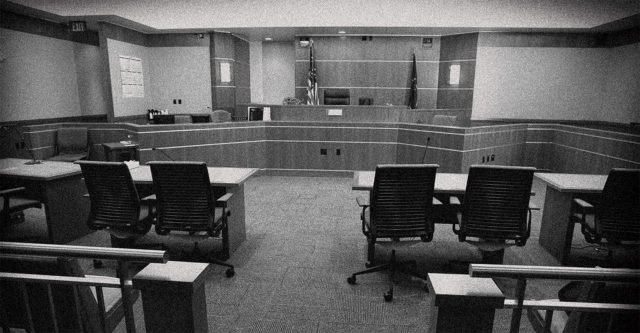The taunts started in the first days of Andre Pryce’s new job, camouflaged as joking. During the nine months of 2019 spent working as a drill rig hand, mostly in the woods in western Pennsylvania, for a contractor that also performs much construction-related drilling, he said coworkers filled his ears with racist insults.
A coworker who wanted to pass him near the door of a temporary tool storage structure, called a doghouse, told him to move and added the N-word to the command. “I didn’t move because that’s not my name,” Pryce said later. But as weeks went by, the coworker kept using the epithet, as well as calling him “boy” almost daily.
Another time, the same coworker made indirect reference to a violent assault on a Black man in the film American History X. “Don’t let me let you bite the curb, boy,” Pryce said he was told. Never having seen the movie, he didn’t understand the implication. Using his phone, the coworker showed Pryce the scene where a white supremacist stomps on the head of a Black man. “Everyone found it as a joke,” Pryce said later about the experience.
With plenty of rope on hand at the well jobsite, Pryce said, his coworkers twice made sure he spotted hangman’s nooses in the doghouse. Another time the coworker presented one to him, referring to it as a “gift” from another colleague. When it was reported, his supervisor laughed and said he would have a talk with the worker involved, according to Pryce.
The reaction to discrimination is most often to deny it, minimize the employer’s legal risk, and, in the process, demonize the rights-claimant.
Ellen Berrey, Robert L. Nelson and Laura Beth Nielsen, Rights on Trial (2017)
Such bold and repugnant taunts and humiliations—once they are investigated and vetted by the U.S. Equal Employment Opportunity Commission as a harassment complaint—would seem to spell big trouble for an employer. The agency has targeted the construction industry as a chronic violator of laws that protect staff from racial and sexual harassment and discrimination. In a report issued in May, EEOC found that industry underrepresentation of women and people of color is caused partly by persistent discrimination and pervasive harassment, often involving virulent forms that include the display of nooses. Indeed, the commission regularly announces new lawsuits and settlements against construction firms. It’s currently pressing a civil action over illegal harassment that allegedly took place at an Arizona plant operated by Schuff Steel Co., the large steel fabricator and erector. The company is vigorously defending itself.
But EEOC records show that not every complaint against an employer, even those in which the agency negotiates a settlement or, more rarely, wins a court damage award, qualifies in every sense as a win.
Various researchers have shown that most successful racial discrimination lawsuit resolutions end with settlements or awards in the $30,000 to $40,000 range per victim. According to Ellen Berrey, a University of Toronto associate professor of sociology—with the comparatively low monetary penalties, EEOC’s investigation process and, if there’s a trial, possible withering criticism by the employer’s defense team—the experience can seem like less than a successful quest for justice. “Yes, employees have the right to file a lawsuit,” says Berrey, co-author of the book Rights on Trial: How Workplace Discrimination Law Perpetuates Inequality (University of Chicago Press, 2017). “Other than that, employers have the advantage at almost every turn. For workers, it’s rare to win, even rarer to come out of a case feeling like they’ve won.”
The matter is especially relevant given construction’s need for more workers and the nationwide pangs of social conscience and reckoning over race provoked by the 2020 murder of George Floyd. Lawsuits over discrimination are widely publicized. But Berrey and her co-authors suggest that attorneys, insurers and industry publications inflate the financial risks, meaning that EEOC’s financial bark is much bigger than its bite. Pryce’s experience—despite EEOC’s billing of the harassment lawsuit it filed on his behalf as a victory—raises important questions about how much its civil lawsuits can help make construction workplaces more welcoming.
At the time of his harassment, Pryce resided in Lemont Furnace, Pa., about 60 miles southeast of Pittsburgh, an area where he also attended high school. He could not be reached for comment and the EEOC staff declined to make him available or speak on the record. Yet a review of the pleadings and transcript of the five-day trial in Pittsburgh’s federal courthouse last fall bears out another aspect of what Berrey and her co-authors wrote. A company personnel system, which educates workers about their rights and trains managers on how to manage in light of those rights, also provides the first line of defense against potential discrimination claims. When it occurs, “the reaction of personnel professionals and defense lawyers, is most often to deny the discrimination took place, minimize the legal risk faced by the employer, and, in the process, demonize the rights-claimant,” the authors wrote.
Pryce also didn’t help himself, his employer’s attorney pointed out, by failing to make journal entries, keep notes or write a log of the incidents. He even acknowledged throwing away the noose presented to him after keeping it at home for a while.
In this case, however, the harassment was real, an eight-person jury decided when the trial finished in early December 2022. But finding no malice by the employer, the jury awarded Pryce only $24,375 in compensation. Andrew L. Scroggins, a partner in the law firm Seyfarth Shaw, which had no involvement in the case, sees it as a good outcome for the employer. “That was a successful defense,” he says.

Pictured is a well similar to ones on which Andre Pryce was employed in 2019 and suffered harassment based on his race, says a complaint by the U.S. Equal Employment Opportunity Commission.
Photo, slightly cropped: NicholaS A. Tonelli under CC License 4.0
Pryce’s employer, Coastal Drilling East, is part of Shaft Drillers International, a Mt. Morris, Pa., collection of eight drilling-related companies, seven of which perform civil construction work, according to the company website. Coastal Drilling East also provided well services to the mining and oil and gas industries, which has created openings for rig hands and laborers like Pryce, who tend to derrick and drill pipes. The employer, which did not respond to requests for comment, had an anti-harassment policy all employees sign, with a section stating, “Every Employee Has a Role to Play in Achieving a Respectful Workplace.” There was even a phone number for employees to report alleged incidents to the human resources department.
In fiscal 2022, EEOC reports there were 475,000 calls, up 18% from the prior year, and that it resolved over 65,000 complaints. If EEOC finds a violation after investigating, it will issue to the employer a determination stating as such and may propose a financial penalty and new anti-harassment policies and training. Scroggins says EEOC staff will sometimes ask the employer how it will fix the situation, but other times the agency locks onto terms it wants and pushes hard to get them. “It’s best to work with the investigator, but I would not do it alone or with only the help of the company human resources or legal department,” says Scroggins. “You want someone experienced with the EEOC.”
Reaching a negotiated resolution, called conciliation, is always best, says Scroggins. It keeps the matter confidential, with EEOC permitted to make terms public only if the employer agrees.
In a conciliation negotiation, the employer benefits by “getting as much information as it can from EEOC and pushing [it] to explain why [the agency] reached the conclusion it did.” EEOC may reveal that there is an entire class of employees involved, rather than just one, or that the illegal treatment involved multiple locations—either of which may be the basis for a more serious charge against the employer.
But rarely is conciliation successful at resolving every issue, says David E. Dubberly, a shareholder at law firm Maynard Nexsen. “EEOC asks for the stars and the moon,” he says. In addition to the monetary penalty, commission staff may ask the employer to sign an order requiring posters and training, often in multiple languages, and things that go beyond what the employer thinks is necessary, he adds.
It is also possible for the penalty to be arranged under a nonbinding mediation, says Dubberly. If it isn’t successful, “the plaintiff will go forward with a lawsuit and the employer will have the expense and inconvenience of mounting a defense.”
EEOC’s lawsuit may also seek restoration of a worker’s job, and financial penalties and punitive damages for especially malicious or reckless discrimination. Importantly, damages are capped for each individual victim, starting at $50,000 for the smaller employers and rising to $300,000 per victim for companies with more than 500 employees.
The majority of cases Dubberly says he and his colleagues see involve a single plaintiff subjected to racial slurs. If there’s a colleague who is a witness and can back the complainant’s account of what happened, the employer will have a hard time winning on a motion for summary judgment, an early decision on the case by a judge. Once the EEOC case survives that, Dubberly says, “it will become a business decision for the employer” about whether to go to trial.
A supervisor using racial slurs automatically creates liability, says Dubberly, but if it’s just coworkers and the employee doesn’t complain, “the law is very clear—the employer should win that case.”
The U.S. Supreme Court set the standard for employer liability in such matters in two 1998 sexual harassment cases, Burlington Industries, Inc. v. Ellerth and Faragher v. City of Boca Raton. Dubberly says an employer “can avoid liability if it exercises reasonable care by having an anti-harassment policy that says, ‘We don’t condone it’ and prohibits it in the strongest terms. The employer also must provide multiple ways for the employee to complain and bring issues to management. If the employer has that policy and the employee signs it and still does nothing, the employer should win.
Pryce had also signed an anti-harassment policy, but according to the court record, it provided for the employee to notify his or her supervisors or the human resources department. Pryce did complain to a supervisor but never to human resources.
Those issues appeared to shape the trial tactics in EEOC’s civil court lawsuit against Coastal Drilling East and a successor company. Pryce alleged that first-line supervisors tacitly condoned the harassment, laughing it off as provocative, over-the-top needling. One witness for the company said Pryce would trade insults with one verbally aggressive coworker. But two employees did admit in testimony to some racist epithets: Straps used in the well work were referred to out loud as “n----r straps.” Also, in its reply to the lawsuit, the firm admitted to the N-word being used a few times. But the company denied that the most grievous humiliations related to the noose or the film scene ever took place.
When the trial started in Pittsburgh’s imposing courthouse, Pryce’s former colleagues and supervisors refrained from any negative comments about him, adding that he was a nice guy who cared about his family. The job of portraying him as a liar was left to Coastal Drilling East’s attorneys.
On the first afternoon, EEOC attorney Megan Block called Pryce to the witness stand to describe the alleged incident in which coworker Jacob Hernandez happily presented him the “gift” noose with a smiling obliviousness to its symbolic threat.

Pittsburgh’s federal courthouse, where the exhibit list and jury verdict sheet in U.S. v. Coastal Drilling East are on file.
Photo, Slightly Cropped: Nyttend via Wikimedia commons
“I didn’t want to respond to it,” Pryce testified. “I felt like if I did, I was going to get in trouble.” Later, while crying, he said, “I was going to do something that I was not going to like, I just did not say anything to him.” Pryce apologized for crying, then testified that he did report the noose to his supervisor. Block drew Pryce out on his feelings about what his coworkers said and did. Months later, when Pryce interviewed for new jobs, the racist taunting still affected him. “It had me second-guessing myself … It made me think like if I get the job I’m going to be treated the same way … It made me look different at people.”
Pryce’s cross-examination by Coastal Drilling East’s main attorney, Sunshine R. Fellows, started as a rapid succession of claims meant to undermine his credibility: that Pryce had signed an anti-harassment policy with the human resource department phone number on it; that he was given a dollar-an-hour raise after he’d been on the job six months; and that his girlfriend had secretly recorded a phone call he had with other Coastal Drilling East employees and supervisors.
Within 15 minutes of beginning cross-examination, Fellows began questioning Pryce’s version of the nooses, eliciting gradually more effacing concessions from him. “The use of rope up in the derricks is necessary for safety reasons … That’s accurate, right?” Pryce agreed. “The derrickhand also needs to use a rope that hooks onto his harness in order to get up in the derricks, right?” Pryce said that was also true.
Fellows made sure the jury heard that Hernandez, who Pryce claimed was one of his most persistent antagonists, once gave him a ride home from the jobsite to his house and back to get lunch. Fellows continued to cross-examine Pryce by zeroing in on the signed anti-harassment policy and the fact that he had never called the human resources phone number to complain.
Block also called Hernandez to the witness stand. She reviewed deposition testimony he had given about the fact that some straps used to prevent the whipping of the drill pipes were called “n----r bands.” She asked Hernandez if he recalled saying in a deposition made before the trial that he heard one of the supervisors refer to the bands using the same words.
But during the trial, Hernandez backed away from his prior comments and said, “it wasn’t something that I specifically remember him saying to me.” Block then asked Hernandez sarcastically, “Were you lying when you gave this deposition or are you lying now?”
When Fellows interrogated Hernandez, she asked him if he had ever seen or made a noose or handed one to Pryce. Each time, Hernandez said no.
Continuing, Fellows next took up the matter of the movie scene. She stated to Hernandez that Pryce had testified that “you pulled up a scene from the movie American History X on your phone and played it for him.” Hernandez replied that he did not “know anything about that incident,” and more often than not, cell phone service at the well jobsite was nonexistent.
On the final day of testimony, Coastal Drilling East’s legal team called the director of the parent firm’s four-person human resources department, Christopher Willis. The holder of a masters’ degree in industrial labor relations, Willis described how workplace investigations, including those for hostile work environments, were part of the core curriculum. Harassment is not tolerated at the company, said Willis. His department can take complaints from employees via multiple channels and anonymously, he told the jury.
Willis testified that he had known Pryce’s two supervisors during his entire 13-year employment at Shaft Drillers International. Had either of them learned of nooses hanging in the doghouse where crews often met, or if one was given to Pryce, or that someone showed Pryce the violent scene from American History X, Willis had no doubt that the information would have been brought to him. The same would have happened if either supervisor had heard that the N-word had been used around Pryce. In discussing his own dealings with Pryce, Willis said that “Andre was a really good employee” and the company wanted to bring him back after Pryce needed time off for medical treatment, so it kept paying him although it was not legally required. But when Pryce recovered and was called in, he did not return. No one, Willis testified, ever told Willis about how Pryce was treated.
(main story text continues below)
How Insurance Can Cut Harassment Risks
The U.S. Equal Employment Opportunity Commission has said that racial harassment and discrimination is pervasive in the construction industry. Employment practices liability insurance, a worthwhile part of a contractor’s business insurance coverage at any time, is more important now, brokers say, since pandemic-related workplace practices and a worldwide focus on diversity and justice are driving more claims against all types of employers.
Because the policies can also provide coverage for wage and hour disputes, wrongful termination, failure to promote or hire and retaliation for reporting incidents, “it is the area of management liability that sees the most activity across the board,” says Brian Dunphy, managing director of Alliant Management and Professional Solutions, a brokerage. While some claims may prove frivolous or relatively easy to resolve, others may include multiple or more serious allegations—all of which need to be investigated, refuted and/or defended.
“That makes employment claims very time-consuming, and very expensive,” he adds.
Indeed, the risk of loss from an employment-related jury trial verdict is also significantly higher. Citing published data from Thomson Reuters, the Insurance Information Institute reports that the median jury award for employer liability claims from all industries approached $260,000 in 2021, a four-fold increase over just six years earlier. Some states are notorious for being litigious, but it’s worth noting that Texas recently surpassed California in the frequency of discrimination and harassment charges, says Dylan Psotka, area senior vice president for broker Arthur J. Gallagher & Co.
Business growth and a more active construction market may explain some of the increase, Psotka says, but it also “is likely an indicator that other states will see a rise in construction-related employment claims as well.”
More claims may arise from the growing role of systems that collect biometric information to record employee attendance and equipment activity. Three states have passed legislation regulating collection of that data.
“It comes down to disclosure on how that information will be used or not used and terminated, and getting employees to sign off on it,” Psotka says. “The documentation becomes the important part.”
Despite these trends, Dunphy says smaller contractors are less likely to purchase the liability coverage than larger peers. One obstacle is the perceived cost of such policies, which varies based on factors such as contractor revenue, assets, number of employees and states in which it operates, he says.
“Construction businesses by and large are thin on cash, and more likely to invest in equipment than risk transfer,” Dunphy explains. He adds that while construction industry claims typically follow the same trends as those of most other industries, the transient nature of the business, with employees joining and leaving companies and projects as needed, “can create the potential for friction between employer and employee, making it rife for a claim.”
Even if a contractor elects to cut its losses via a negotiated settlement, Dunphy says the financial impact on a small firm could be “catastrophic,” especially if it’s already struggling. As with any business insurance, contractors should consult brokers and advisors with a strong understanding of construction industry nuances, experts say.
While the base policy is largely the same among carriers, there may be exclusions such as bodily injury, property damage, abuse and molestation claims, as well as employment contracts for highly paid employees. Wage and hour claims coverage also may have to be purchased separately. Policies will generally provide for defense against EEOC complaints, according to Dunphy, as long as all policy terms are followed, such as the notice provision and cooperation clause.
A typical policy has a limit of $500,000 or $1 million, according to the law firm LightGabler. Retention generally makes the policyholder responsible for the first several tens of thousands of dollars.
Even with the coverage, contractors can take steps to minimize the risk of an employment-related claim through training, zero-tolerance for discrimination and harassment and clear communication of those values to all staff. Brokers and insurance companies offer a variety of resources to help contractors establish or bolster existing training programs.
“It’s really about having a robust and vigilant human resources team to remind people of what is expected from a conduct perspective, and make sure everyone follows through,” Dunphy says. “It has to be a regular practice.”
Contractors also need to be mindful of their exposure, believe EEOC about its focus on construction, Psotka says, “and take discrimination and harassment as seriously as they take their safety program.”
By Jim Parsons
’We Hide Nothing’
The company “believes in doing what’s right, not because it’s easy, but because it’s right,” Willis testified. About Pryce’s supervisors and crew—“you are talking about some of the best people I know.” The first time Willis heard the allegations, he was furious “that it came from outside,” adding, “we hide nothing.”
Did Pryce invent the story of the movie scene and noose? Or was he subject at first to small and then to larger, nastier racist goads that, while he reacted with restraint, gnawed at him and led to the lawsuit?
The jurors found both coworkers and supervisors engaged in unlawful harassment but said there was no malice by Coastal Drilling East and awarded no punitive damages. Block followed up the verdict with a motion, approved by Judge Joy F. Conti, requiring the company not to authorize the two supervisors involved to “decline to report to their managers” or the human resources department “any complaints or observations" of racial harassment. The judge ordered the company not to tolerate a hostile work environment “including but not limited to workplace use of racial slurs or epithets, racial jokes, the display of nooses, or other racially offensive words or images.”
Block filed another motion for more compensation to Pryce based on lost wages from his forced exit because of harassment—called a “constructive discharge”—and time he spent unemployed. In September, Conti added $56,000 to the $24,375 jury award.
The court record also shows that Pryce, after months of unemployment, eventually bettered his former annual pay on the drilling crew, $46,000, with an $84,000-a-year truck-driving job. His conversations with new colleagues now may be fewer as he spends time on the road, behind the wheel and by himself.










